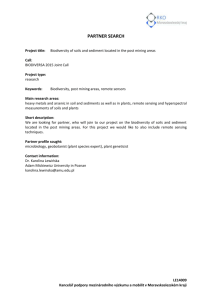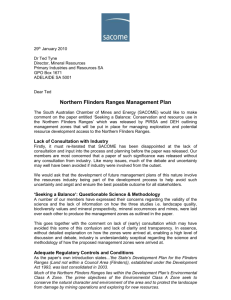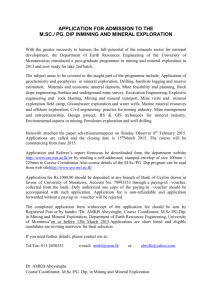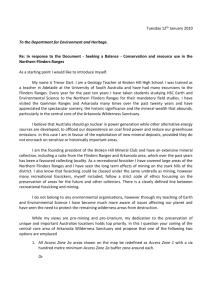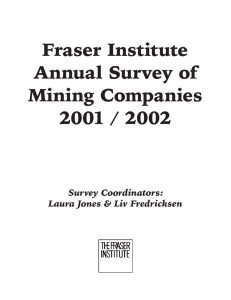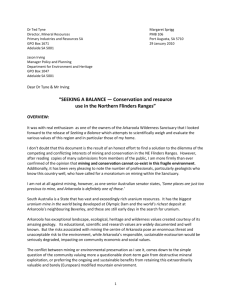Mr Jason Irving,
advertisement
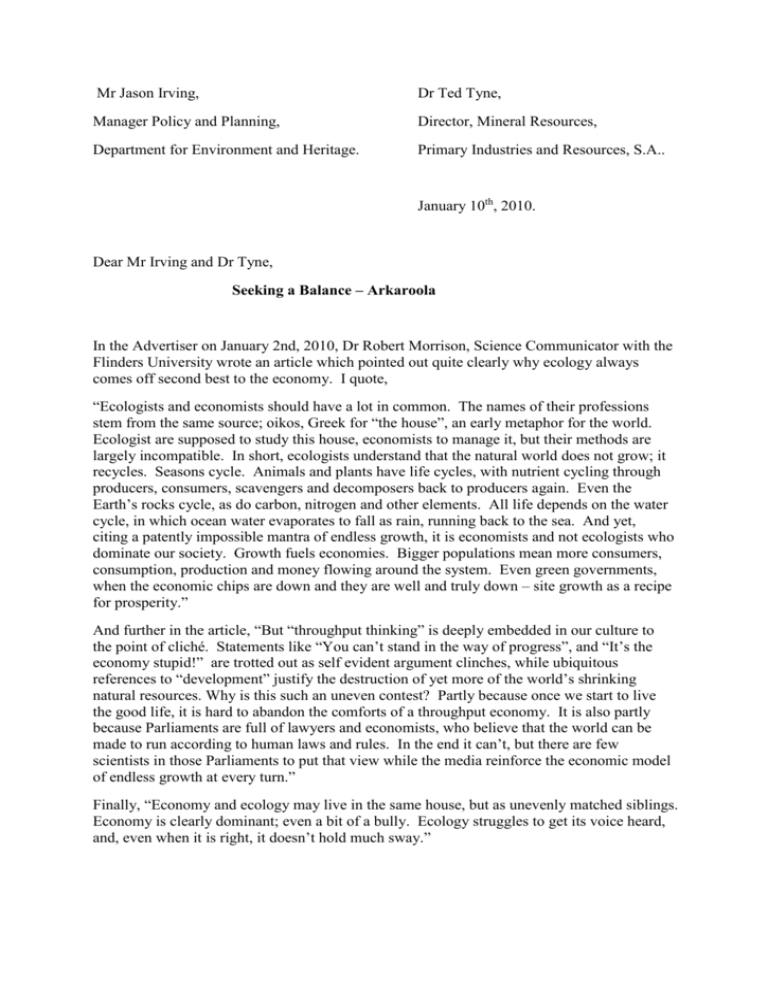
Mr Jason Irving, Dr Ted Tyne, Manager Policy and Planning, Director, Mineral Resources, Department for Environment and Heritage. Primary Industries and Resources, S.A.. January 10th, 2010. Dear Mr Irving and Dr Tyne, Seeking a Balance – Arkaroola In the Advertiser on January 2nd, 2010, Dr Robert Morrison, Science Communicator with the Flinders University wrote an article which pointed out quite clearly why ecology always comes off second best to the economy. I quote, “Ecologists and economists should have a lot in common. The names of their professions stem from the same source; oikos, Greek for “the house”, an early metaphor for the world. Ecologist are supposed to study this house, economists to manage it, but their methods are largely incompatible. In short, ecologists understand that the natural world does not grow; it recycles. Seasons cycle. Animals and plants have life cycles, with nutrient cycling through producers, consumers, scavengers and decomposers back to producers again. Even the Earth’s rocks cycle, as do carbon, nitrogen and other elements. All life depends on the water cycle, in which ocean water evaporates to fall as rain, running back to the sea. And yet, citing a patently impossible mantra of endless growth, it is economists and not ecologists who dominate our society. Growth fuels economies. Bigger populations mean more consumers, consumption, production and money flowing around the system. Even green governments, when the economic chips are down and they are well and truly down – site growth as a recipe for prosperity.” And further in the article, “But “throughput thinking” is deeply embedded in our culture to the point of cliché. Statements like “You can’t stand in the way of progress”, and “It’s the economy stupid!” are trotted out as self evident argument clinches, while ubiquitous references to “development” justify the destruction of yet more of the world’s shrinking natural resources. Why is this such an uneven contest? Partly because once we start to live the good life, it is hard to abandon the comforts of a throughput economy. It is also partly because Parliaments are full of lawyers and economists, who believe that the world can be made to run according to human laws and rules. In the end it can’t, but there are few scientists in those Parliaments to put that view while the media reinforce the economic model of endless growth at every turn.” Finally, “Economy and ecology may live in the same house, but as unevenly matched siblings. Economy is clearly dominant; even a bit of a bully. Ecology struggles to get its voice heard, and, even when it is right, it doesn’t hold much sway.” All of the above could be applied to the appalling situation whereby it is proposed to downgrade the protection for Arkaroola and immediate surroundings. It is obvious that the basis for the assessment of protection in this region leaves a lot to be desired. The government produced document states that “Much of the Northern Flinders Ranges lie within the Development Plan’s Environmental Class A Zone. It is states that the prime objectives of the Environmental Class A Zone seeks to conserve the natural character and environment of the area and to protect the landscape from damage by mining operations and exploring for new resources.” Yet by rezoning much of the area, this so-called protection is being massively downgraded. Zone 2a is stated to be “no high impact activities accepted”, yet there is no definition of what constitutes a high impact or even a low impact for that matter. There is a list given of what will be permitted, but even this is muddied by such broad terms as “other low impact exploration activities”. What constitutes “minimal disturbance to flora and fauna? There seems little difference between Zone 2A and Zone 2b. For example what is the difference between “minimal disturbance to flora and fauna”, (Zone A) and “temporary ground disturbing activities permitted and minimal disturbance to flora and fauna, and landform?” (Zone 2b) Is heavy earth moving equipment considered to be low impact? I wouldn’t have thought so. It beggars belief that in this vast, geologically, biologically, culturally and ecologically significant area, that only such a small area of it is considered worthy by government to be afforded the utmost protection from the permanent scarring mineral exploration and research leaves in its wake! Under the heading of “Protecting the Value of the Northern Flinders Ranges”, it is stated “reflecting these objectives, Government already places strict conditions and regulatory controls on mineral and energy exploration and on proposed mining activities in the region.” Unfortunately those “strict conditions and regulatory controls”, were shown to have failed completely when it became public that Marathon Exploration’s inappropriate uranium exploration methods resulted in the illegal burial of more than 40 tonnes of low-level radioactive waste at Mount Gee. Similar waste was also disposed of in the Yudnamutana Gorge. So much for protection of the Environmental Class A Zone! This does not provide faith for future protection under any Zone, let alone the major ones. The least that the public would have expected is for a complete buffer zone to have been implemented to further secure important areas. Zoning appears to have been worked out strictly according to the three maps in the document, i.e., landscape quality, biodiversity values and mineral prospectivity. As a layperson I cannot contribute to the debate upon the landscape quality although I have visited the area several times and have marvelled at the wonderful formations in the ranges. I have also taken international visitors who have been amazed at the area and speak glowingly of their experiences there. How something as unique as Siller’s Outlook is not deemed worthy of being protected when it is one of the best-known features of the area is just inconceivable! I can however offer something as far as biodiversity is concerned. Looking at the map it is obvious that there are many hotspots throughout the Ranges that are considered important. Anyone who knows anything about modern conservation and in particular conserving biodiversity, is aware that there has to be corridors to allow populations to move through to be able to survive to meet stresses that populations are subjected to from time to time. Such a corridor is sadly lacking in the plan. Again on a personal note I have been involved with conservation of the yellow footed rock Wallaby and know that Arkaroola provides one of the great strongholds for this unique animal and any impact from mining in particular, can only be detrimental to its survival. This specifically goes against the Department of Environment’ s own Naturelinks program which recognises the need for biodiversity corridors. This brings me to the third map dealing with mineral prospectivity. Already mining and prospecting is a hotchpotch that threatens the area, particularly the most sensitive areas. Rezoning is only going to exacerbate the problems that mining inevitably brings with it. There appears to have been no taking into account one of the most dire issues facing this state – and that is water. Where is the water to come from for any new mines? The public is now aware of how much water is required to run a mining operation – and of the inequitable deal whereby the public pays for the use of its water, and mining companies using millions of litres of water a day, don’t! Any water taken from underground/ground sources will only threaten the survival of animals, plant, trees, and the village itself. It will undoubtedly detract, if not eventually destroy, this beautiful landscape – and for what? Only a short term gain at the expense of something that once gone, can never be replaced. There are many other issues that the paper does not address, such as the cultural heritage of the traditional owners in the area. As far as the Geoscience value of the area is concerned, it is absolutely unique. The succession of owners of Arkaroola have always been at the forefront of its conservation, but they have also generously shared with students, scientists, and tourists, the vast history and wonders of Arkaroola. The value of tourism will last long after that of mining if the area is adequately protected. Somewhere along the line governments have to realise that there are some things that the almighty dollar cannot buy. We already have this wonderful asset, this History of Time to our North and it needs to be protected for generations to come. If there were to be a referendum on whether or not we should be mining in these very sensitive areas around Arkaroola, and allowing the area to be a plethora of different zones that do not afford protection to areas of significance or provide a corridor for biodiversity, there would be little doubt that the public would vote no. I suspect government already knows that. There is a vast amount of area around the Beverly uranium mine to the East of Arkaroola and other sensitive areas, where exploration can take place. An imaginary line could be drawn from Moolawatana in the North, West of Mount Freeling , East of Umbertana to the Gammon Ranges National Park in the South that could provide for Zone 3 activities. In closing I again refer you to the wise writing of Dr. Rob Morrison, ‘Economy and ecology may live in the same house, but as unevenly matched siblings.” It is time that the ecology was given a more prominent place in government planning and for government not to view the economy as the only thing that matters. If there is no ecology, the fact is that there will soon be no economy. Yours sincerely, Elaine J. Attwood (personal contact details deleted) (personal contact details deleted)

